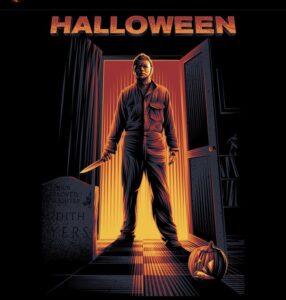
As one of the most popular series in Hollywood history, “Halloween” now has its 12th installment with “Halloween Kills.” The sequel to “Halloween,” “Halloween Kills,” finds Michael Myers escaping the fiery inferno Laurie Strode and her family forced him into as he continues his rampage across Haddonfield, setting the stage for next year’s finale.
After Myers becomes ensnared in Laurie Strode’s daughter Karen’s [Judy Greer] trap in “Halloween Kills,” he gets the cockroach treatment. In the street outside his childhood home, Haddonfield citizens beat him down with bullets, bats and blood. Michael appears dead — suddenly dead — as the score from John Carpenter’s 1978 original echoes over the carnage. The scene is reminiscent of watching Karen insert a knife into Michael’s spine.
But among shaken survivors who still wrap themselves in blankets provided by the EMTs, he reanimates. Michael kills Karen inside his former home after taking out his enemies, including Tommy Doyle [Anthony Michael Hall].
The previous movies have explicitly confirmed the existence of Michael’s supernatural abilities. In 1988 and 1989, the films “Halloween 4: The Return of Michael Myers” and “Halloween 5: The Revenge of Michael Myers,” laid the foundation for Michael’s supernatural strength and stealth to be attributed to some otherworldly force. “Halloween 6: The Curse of Michael Myers” in 1995 tied Myers’ origin to a cult that worshipped demons while portraying him as a sympathetic figure who had been victimized on a childhood playground.
Nevertheless, supernatural events seemed to be off the table in this latest iteration. In the 2018 sequel, 40 years have passed since the 1978 “Halloween,” and Michael has become a very human killer who is somehow obsessed with Laurie.
Michael’s fake-out death could’ve been handled nicely without any supernatural elements in “Halloween Kills.” Laurie kills Michael with an ax in 1998’s “Halloween: 20 Years Later,” but the 2002 “Halloween: Resurrection” clarifies this was a mistaken identity killing. In addition, Michael’s survival is explained at the beginning of “Halloween Kills” due to a fireproof metal door and a potentially ill-advised rescue.
“Halloween Kills” creates a frustrating data point by showing what should have been Michael’s definitive end and then allows him to rise immediately after. This sets up the possibility of reconciling his discordant legacy in the following chapters.
David Gordon Green appears inclined to put his own spin on the movie, in contrast to other Halloween directors.
According to Mashable.com, “Sure, arguing that an ending is good because it makes you excited for the next one is part of the insidious scam that is franchise slashers. “Halloween Kills” made $50.4 million at the box office. And despite the controversy, you can bet “Halloween Ends” will do even better. Still, for my money, acknowledging the cyclical nature of a franchise as emotionally captivating and freaky frugal as this one remains the right choice.
That night, evil did not die. But evil never dies. For Michael, it’s all about that. Until you face that reality, you’ll never enjoy what’s right in front of you.